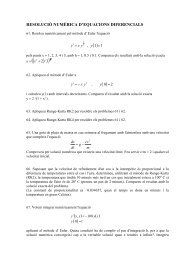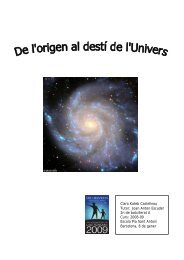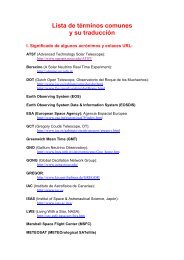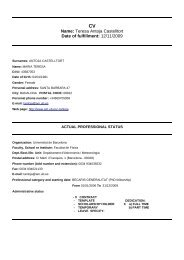Universitat de - Departament d'Astronomia i Meteorologia ...
Universitat de - Departament d'Astronomia i Meteorologia ...
Universitat de - Departament d'Astronomia i Meteorologia ...
You also want an ePaper? Increase the reach of your titles
YUMPU automatically turns print PDFs into web optimized ePapers that Google loves.
1.1. X-ray binaries 7<br />
Galactic latitu<strong>de</strong> [<strong>de</strong>g]<br />
90<br />
60<br />
30<br />
0<br />
−30<br />
−60<br />
Low Mass X−ray Binaries<br />
−90<br />
180 120 60 0 300 240 180<br />
Galactic longitu<strong>de</strong> [<strong>de</strong>g]<br />
Figure 1.2: Distribution of catalogued LMXBs in galactic coordinates. LMC stands for<br />
Large Magellanic Cloud. The dashed line represents the galactic plane.<br />
Fig. 1.1, these systems do not trace the galactic disk, and are located in the galactic<br />
bulge and in globular clusters at relatively high galactic latitu<strong>de</strong>s, because are old<br />
stellar systems of Population II. Only two LMXBs are catalogued in the LMC, and<br />
none in the SMC.<br />
In Table 1.2 we list the number of different types of LMXBs within the SMC,<br />
the LMC, the Galaxy and total values. There are only 5 XPs, i.e., ∼ 3% of the<br />
149 catalogued LMXBs, compared to the ∼ 54% in HMXBs. This fact tells us that<br />
most of LMXBs are low magnetic field NSs or BHs. Two of these XPs are also X-ray<br />
bursters. There are 63 X-ray bursters, all of them containing NS compact objects.<br />
A total of 6 Z sources have been found in the Galaxy, while 1 is suspected in the<br />
LMC (omitted here). There are 18 Atoll sources, of which 16 are X-ray bursters,<br />
LMC






